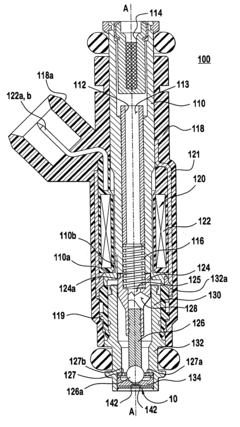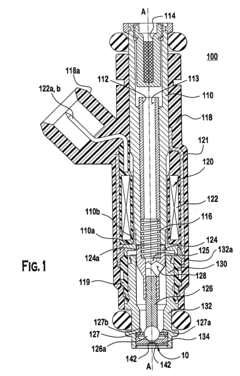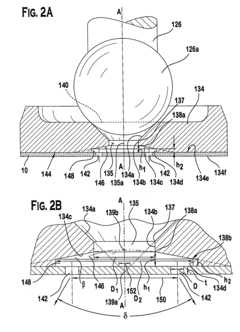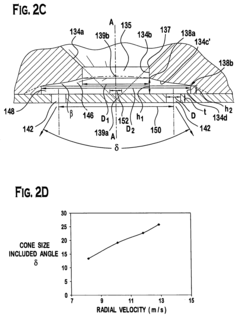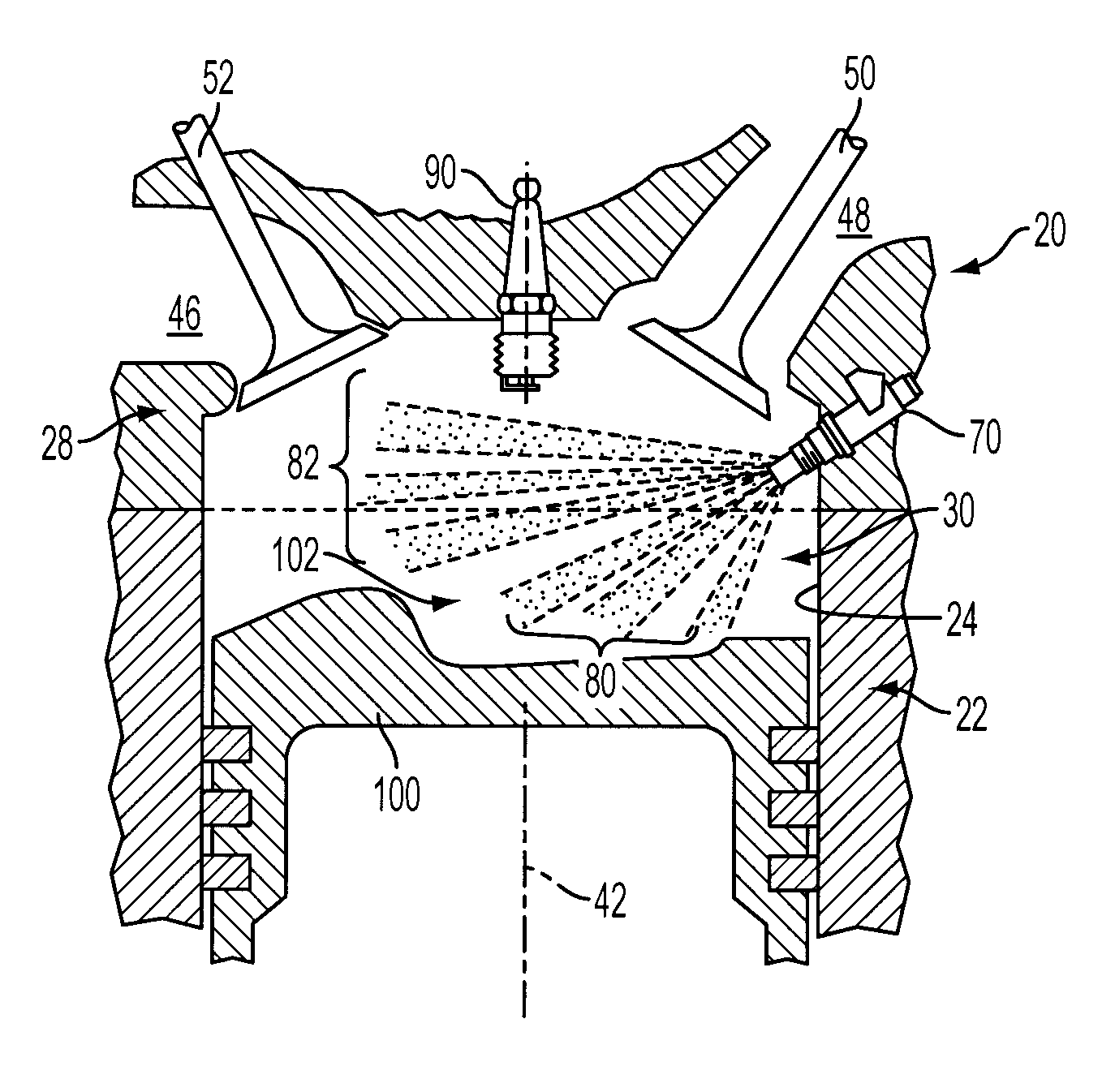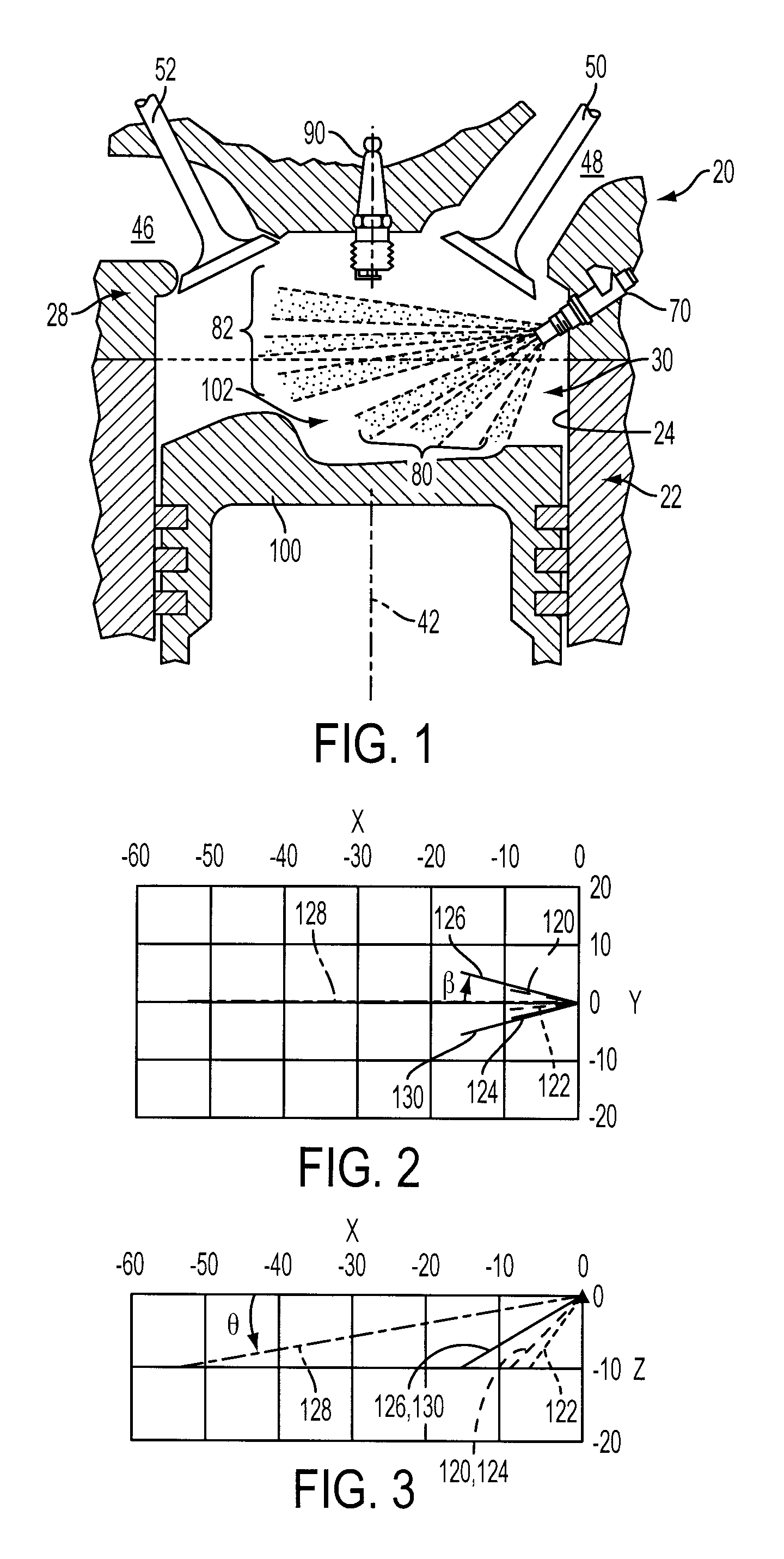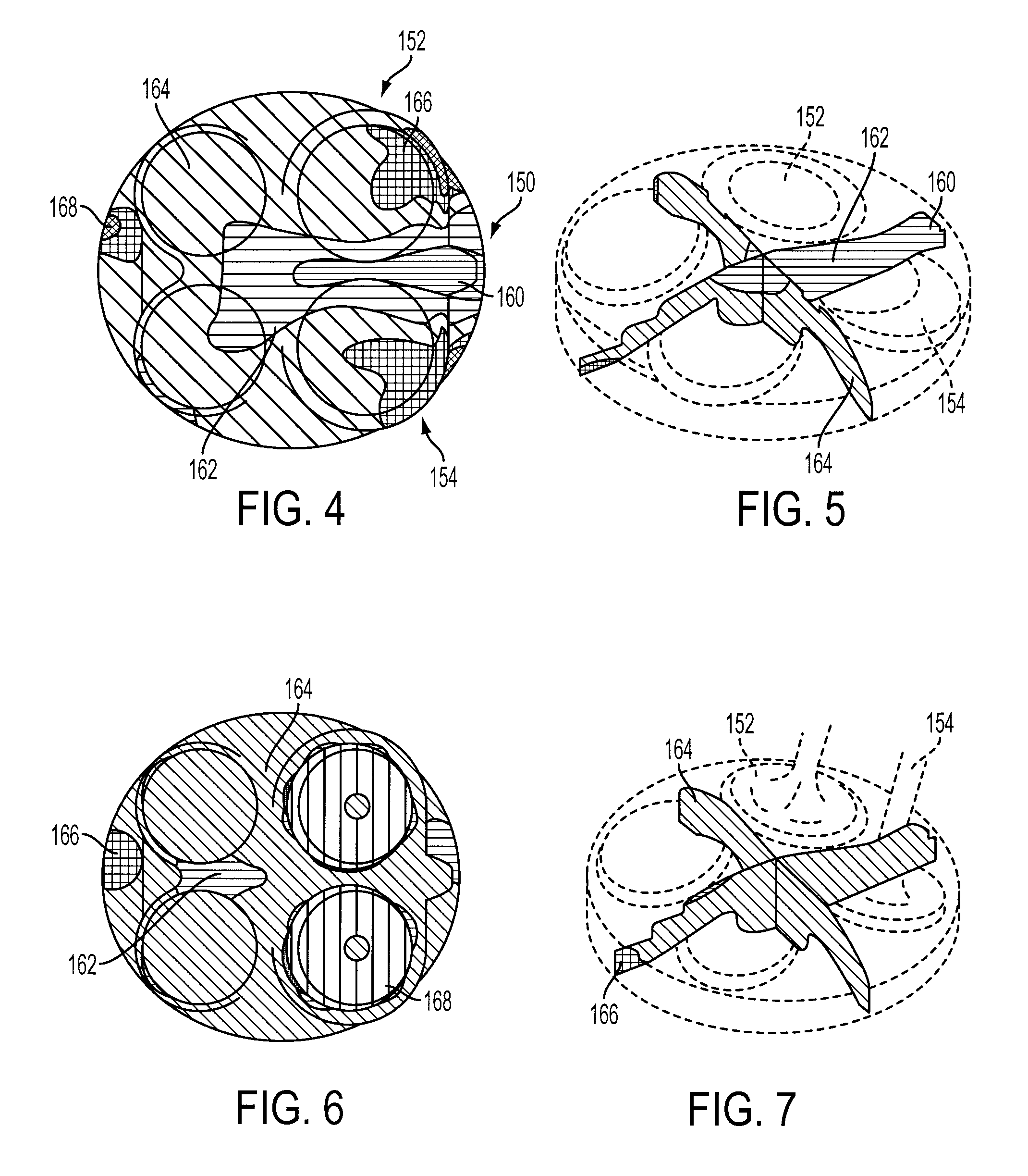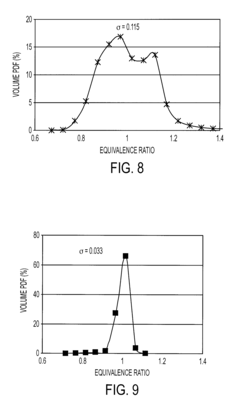Benchmark LS2 Engine Fuel Injector Efficiency: Spray Pattern Analysis
SEP 3, 20259 MIN READ
Generate Your Research Report Instantly with AI Agent
Patsnap Eureka helps you evaluate technical feasibility & market potential.
LS2 Engine Fuel Injection Technology Background and Objectives
The LS2 engine, introduced by General Motors in 2005, represents a significant evolution in the company's small-block V8 engine family. This 6.0-liter powerplant featured advanced fuel injection technology that marked a departure from previous generations, transitioning from traditional multi-port fuel injection to a more sophisticated electronic fuel injection system. The technological progression in fuel injection systems has been driven by increasingly stringent emissions regulations, performance demands, and fuel efficiency requirements across the automotive industry.
Fuel injector technology has evolved substantially since the first mechanical injection systems of the 1950s, moving through continuous injection systems, electronic fuel injection, and now into direct injection technologies. The LS2's fuel injection system represents an important intermediate stage in this evolution, utilizing sequential fuel injection with improved atomization capabilities compared to its predecessors.
The primary objective of analyzing the LS2 engine's fuel injector spray pattern efficiency is to establish benchmark performance metrics that can inform future development of fuel delivery systems. By understanding the atomization characteristics, spray geometry, and temporal consistency of the LS2 injectors, engineers can identify specific areas for improvement in newer generation engines.
Current industry trends point toward increasingly precise fuel delivery systems that optimize combustion efficiency while minimizing emissions. The LS2's injection technology provides a valuable reference point for measuring advancements in spray pattern uniformity, droplet size distribution, and penetration characteristics that directly impact combustion efficiency.
The technical goals of this benchmarking study include quantifying the spray pattern consistency across operational conditions, measuring droplet size distribution at various fuel pressures, analyzing the temporal stability of injection events, and evaluating the geometric uniformity of the spray cone. These measurements will establish a performance baseline against which newer technologies can be compared.
Additionally, this analysis aims to identify the relationship between injector spray characteristics and real-world performance metrics such as power output, emissions profile, and fuel economy. Understanding these correlations will help prioritize which spray pattern attributes most significantly impact overall engine performance.
The historical context of the LS2 engine's development is particularly relevant, as it emerged during a transitional period in emissions regulations and fuel economy standards. The injection technology represented GM's response to these changing requirements while maintaining the performance characteristics expected from their V8 lineup.
Fuel injector technology has evolved substantially since the first mechanical injection systems of the 1950s, moving through continuous injection systems, electronic fuel injection, and now into direct injection technologies. The LS2's fuel injection system represents an important intermediate stage in this evolution, utilizing sequential fuel injection with improved atomization capabilities compared to its predecessors.
The primary objective of analyzing the LS2 engine's fuel injector spray pattern efficiency is to establish benchmark performance metrics that can inform future development of fuel delivery systems. By understanding the atomization characteristics, spray geometry, and temporal consistency of the LS2 injectors, engineers can identify specific areas for improvement in newer generation engines.
Current industry trends point toward increasingly precise fuel delivery systems that optimize combustion efficiency while minimizing emissions. The LS2's injection technology provides a valuable reference point for measuring advancements in spray pattern uniformity, droplet size distribution, and penetration characteristics that directly impact combustion efficiency.
The technical goals of this benchmarking study include quantifying the spray pattern consistency across operational conditions, measuring droplet size distribution at various fuel pressures, analyzing the temporal stability of injection events, and evaluating the geometric uniformity of the spray cone. These measurements will establish a performance baseline against which newer technologies can be compared.
Additionally, this analysis aims to identify the relationship between injector spray characteristics and real-world performance metrics such as power output, emissions profile, and fuel economy. Understanding these correlations will help prioritize which spray pattern attributes most significantly impact overall engine performance.
The historical context of the LS2 engine's development is particularly relevant, as it emerged during a transitional period in emissions regulations and fuel economy standards. The injection technology represented GM's response to these changing requirements while maintaining the performance characteristics expected from their V8 lineup.
Market Demand Analysis for High-Efficiency Fuel Injection Systems
The global market for high-efficiency fuel injection systems has experienced substantial growth over the past decade, driven primarily by increasingly stringent emission regulations and consumer demand for improved fuel economy. The automotive industry's shift toward more environmentally friendly vehicles has created a significant market opportunity for advanced fuel injection technologies, particularly those that optimize spray patterns and combustion efficiency.
Current market analysis indicates that the high-efficiency fuel injection systems market was valued at approximately $73.5 billion in 2022 and is projected to reach $102.3 billion by 2028, representing a compound annual growth rate (CAGR) of 5.7%. This growth trajectory is supported by regulatory frameworks such as Euro 7 in Europe, China 6 in Asia, and Corporate Average Fuel Economy (CAFE) standards in North America.
For LS2 engine applications specifically, market research shows increasing demand for precision-engineered fuel injectors that can deliver optimal spray patterns. Performance vehicle owners and aftermarket enthusiasts represent a significant segment, with over 65% of LS2 engine owners considering fuel system upgrades within the first three years of ownership.
The commercial vehicle sector has emerged as another substantial market driver, with fleet operators actively seeking fuel efficiency improvements to reduce operating costs. Studies indicate that a 3-5% improvement in fuel efficiency through advanced injection systems can translate to annual savings of $3,000-$5,000 per heavy-duty vehicle.
Regional market analysis reveals North America as the dominant market for LS2 engine fuel injection systems, accounting for 42% of global demand, followed by Europe (27%) and Asia-Pacific (21%). The aftermarket segment for these systems is growing at 6.3% annually, outpacing OEM installations.
Consumer preference data indicates a willingness to pay premium prices for fuel injection systems that demonstrate measurable performance improvements. Survey results show that 78% of performance vehicle owners prioritize fuel efficiency alongside power gains when considering engine modifications.
The market is also witnessing increased demand for diagnostic and testing equipment related to spray pattern analysis, with this segment growing at 8.2% annually. This trend underscores the importance of spray pattern optimization in achieving desired performance and efficiency outcomes.
Industry forecasts suggest that technological innovations focusing on spray pattern optimization could capture significant market share, with potential for 15-20% premium pricing for systems that demonstrate superior atomization characteristics and combustion efficiency in LS2 engine applications.
Current market analysis indicates that the high-efficiency fuel injection systems market was valued at approximately $73.5 billion in 2022 and is projected to reach $102.3 billion by 2028, representing a compound annual growth rate (CAGR) of 5.7%. This growth trajectory is supported by regulatory frameworks such as Euro 7 in Europe, China 6 in Asia, and Corporate Average Fuel Economy (CAFE) standards in North America.
For LS2 engine applications specifically, market research shows increasing demand for precision-engineered fuel injectors that can deliver optimal spray patterns. Performance vehicle owners and aftermarket enthusiasts represent a significant segment, with over 65% of LS2 engine owners considering fuel system upgrades within the first three years of ownership.
The commercial vehicle sector has emerged as another substantial market driver, with fleet operators actively seeking fuel efficiency improvements to reduce operating costs. Studies indicate that a 3-5% improvement in fuel efficiency through advanced injection systems can translate to annual savings of $3,000-$5,000 per heavy-duty vehicle.
Regional market analysis reveals North America as the dominant market for LS2 engine fuel injection systems, accounting for 42% of global demand, followed by Europe (27%) and Asia-Pacific (21%). The aftermarket segment for these systems is growing at 6.3% annually, outpacing OEM installations.
Consumer preference data indicates a willingness to pay premium prices for fuel injection systems that demonstrate measurable performance improvements. Survey results show that 78% of performance vehicle owners prioritize fuel efficiency alongside power gains when considering engine modifications.
The market is also witnessing increased demand for diagnostic and testing equipment related to spray pattern analysis, with this segment growing at 8.2% annually. This trend underscores the importance of spray pattern optimization in achieving desired performance and efficiency outcomes.
Industry forecasts suggest that technological innovations focusing on spray pattern optimization could capture significant market share, with potential for 15-20% premium pricing for systems that demonstrate superior atomization characteristics and combustion efficiency in LS2 engine applications.
Current State and Challenges in Fuel Injector Spray Pattern Analysis
The current state of fuel injector spray pattern analysis for LS2 engines reveals significant advancements alongside persistent technical challenges. Globally, high-speed imaging technologies have become the standard methodology for spray pattern analysis, with resolutions now capable of capturing droplet formations at microsecond intervals. These systems typically employ laser sheet illumination combined with high-speed cameras operating at 10,000+ frames per second, allowing researchers to observe the complex fluid dynamics during injection events.
Despite these technological capabilities, standardization remains a significant obstacle in the field. Different manufacturers employ varying methodologies for spray pattern analysis, making direct comparisons between injector performances problematic. This lack of standardized testing protocols creates inconsistencies in reported efficiency metrics across the industry, particularly for the LS2 platform.
The geographical distribution of fuel injector technology development shows concentration in automotive manufacturing hubs, with significant research clusters in North America, Germany, Japan, and increasingly in China. Each region has developed specialized approaches to spray pattern analysis, with German precision engineering focusing on droplet uniformity while Japanese research emphasizes atomization efficiency.
A major technical limitation currently facing researchers is the difficulty in simultaneously analyzing both macroscopic spray characteristics and microscopic droplet formation. Most existing systems excel at one scale but sacrifice detail at the other. This creates a fundamental gap in understanding the complete injection event from initial spray formation to combustion chamber distribution.
Environmental testing conditions present another significant challenge. Laboratory analysis often fails to accurately replicate real-world operating conditions, particularly the dynamic pressure and temperature variations experienced in actual LS2 engine operation. The discrepancy between controlled testing environments and real-world performance creates reliability issues when translating research findings to production applications.
Computational modeling capabilities, while advanced, still struggle with accurately predicting spray patterns under all operating conditions. Current CFD (Computational Fluid Dynamics) models require extensive validation against physical tests, limiting their predictive value for novel injector designs. The computational intensity required for accurate modeling remains prohibitively high for many development teams.
Material limitations also constrain injector development, as nozzle designs must balance durability against precision manufacturing requirements. Advanced materials capable of withstanding high temperatures and pressures while maintaining precise spray geometries remain an active area of research, with ceramic composites and specialized metal alloys showing promise but requiring further development for mass production viability.
Despite these technological capabilities, standardization remains a significant obstacle in the field. Different manufacturers employ varying methodologies for spray pattern analysis, making direct comparisons between injector performances problematic. This lack of standardized testing protocols creates inconsistencies in reported efficiency metrics across the industry, particularly for the LS2 platform.
The geographical distribution of fuel injector technology development shows concentration in automotive manufacturing hubs, with significant research clusters in North America, Germany, Japan, and increasingly in China. Each region has developed specialized approaches to spray pattern analysis, with German precision engineering focusing on droplet uniformity while Japanese research emphasizes atomization efficiency.
A major technical limitation currently facing researchers is the difficulty in simultaneously analyzing both macroscopic spray characteristics and microscopic droplet formation. Most existing systems excel at one scale but sacrifice detail at the other. This creates a fundamental gap in understanding the complete injection event from initial spray formation to combustion chamber distribution.
Environmental testing conditions present another significant challenge. Laboratory analysis often fails to accurately replicate real-world operating conditions, particularly the dynamic pressure and temperature variations experienced in actual LS2 engine operation. The discrepancy between controlled testing environments and real-world performance creates reliability issues when translating research findings to production applications.
Computational modeling capabilities, while advanced, still struggle with accurately predicting spray patterns under all operating conditions. Current CFD (Computational Fluid Dynamics) models require extensive validation against physical tests, limiting their predictive value for novel injector designs. The computational intensity required for accurate modeling remains prohibitively high for many development teams.
Material limitations also constrain injector development, as nozzle designs must balance durability against precision manufacturing requirements. Advanced materials capable of withstanding high temperatures and pressures while maintaining precise spray geometries remain an active area of research, with ceramic composites and specialized metal alloys showing promise but requiring further development for mass production viability.
Current Benchmark Methodologies for Fuel Injector Efficiency Assessment
01 Spray pattern optimization for fuel efficiency
Optimizing the spray pattern of fuel injectors in LS2 engines can significantly improve fuel efficiency. This involves designing injectors that produce a fine, evenly distributed mist that promotes better air-fuel mixing. The spray pattern can be tailored to match the combustion chamber geometry, ensuring complete combustion and reducing fuel waste. Advanced spray patterns can also help maintain optimal fuel pressure and distribution across different engine operating conditions.- Spray pattern optimization for fuel efficiency: Optimizing the spray pattern of fuel injectors in LS2 engines can significantly improve fuel efficiency. This involves designing injectors that produce a fine, evenly distributed spray pattern that promotes better fuel atomization. The improved atomization leads to more complete combustion, reducing fuel consumption and emissions. Various techniques such as adjusting the spray angle, droplet size, and distribution pattern are employed to achieve optimal fuel-air mixture formation in the combustion chamber.
- Multi-hole injector designs for LS2 engines: Multi-hole injector designs are specifically engineered for LS2 engines to create precise spray patterns. These injectors feature multiple orifices arranged in specific configurations to direct fuel spray in patterns that match the combustion chamber geometry. The number, size, and arrangement of these holes are carefully calibrated to ensure optimal fuel distribution throughout the cylinder. This design helps prevent wall wetting and promotes better mixture formation, resulting in improved combustion efficiency and reduced emissions.
- Electronically controlled spray pattern adaptation: Advanced electronic control systems are implemented in LS2 engine fuel injectors to dynamically adapt spray patterns based on operating conditions. These systems can modify injection timing, duration, and pressure to optimize the spray pattern for different engine loads and speeds. By continuously adjusting the spray characteristics in real-time, these systems ensure optimal combustion efficiency across various driving conditions. This adaptive capability helps maintain performance while minimizing emissions and fuel consumption throughout the engine's operating range.
- High-pressure direct injection spray patterns: High-pressure direct injection systems for LS2 engines utilize specialized spray patterns designed to work under increased fuel pressures. These systems produce finer droplet sizes and more precise spray patterns, allowing for better mixture formation directly in the combustion chamber. The high-pressure spray patterns are engineered to penetrate the dense air charge while maintaining optimal distribution. This approach enables more precise control over the combustion process, resulting in improved power output, reduced emissions, and better fuel economy in LS2 engines.
- Cold-start spray pattern optimization: Specialized spray patterns are developed for LS2 engine fuel injectors to address cold-start conditions. These patterns are designed to compensate for poor fuel vaporization in cold engines by adjusting spray characteristics such as cone angle, penetration depth, and droplet size. During cold starts, the injectors may use different spray patterns that enhance fuel atomization and wall-guided mixing to ensure reliable ignition and combustion stability. This optimization helps reduce cold-start emissions and improves drivability during engine warm-up periods.
02 Multi-hole injector designs for LS2 engines
Multi-hole injector designs provide superior spray patterns for LS2 engines by creating multiple fuel streams that improve atomization and distribution. These designs typically feature strategically positioned orifices that direct fuel in patterns optimized for the LS2 combustion chamber geometry. The number, size, and angle of these holes significantly impact the spray pattern, with modern designs featuring up to 12 holes to create ideal spray patterns that enhance combustion efficiency and reduce emissions.Expand Specific Solutions03 Direct injection spray pattern technology
Direct injection systems for LS2 engines utilize specialized spray patterns that deliver fuel directly into the combustion chamber. These systems require precisely engineered spray patterns to work effectively with the high-pressure environment of direct injection. The spray pattern must be designed to avoid wall wetting while ensuring proper fuel distribution throughout the combustion chamber. Advanced direct injection spray patterns often incorporate swirl or tumble flow characteristics to enhance air-fuel mixing under various engine loads.Expand Specific Solutions04 Electronic control of spray patterns
Electronic control systems can dynamically adjust fuel injector spray patterns in LS2 engines based on operating conditions. These systems modify injection timing, duration, and pressure to optimize the spray pattern for different engine speeds and loads. Advanced electronic control units can implement multiple injection events per cycle, creating complex spray pattern sequences that improve combustion efficiency. This technology enables spray patterns to adapt to cold starts, high-performance demands, and fuel economy modes.Expand Specific Solutions05 Spray pattern design for emissions reduction
Specialized spray patterns can significantly reduce emissions from LS2 engines by promoting more complete combustion. These patterns are designed to minimize the formation of particulate matter and nitrogen oxides by ensuring optimal air-fuel mixing. The spray pattern geometry can be tailored to create ideal fuel distribution that prevents rich or lean pockets within the combustion chamber. Advanced spray patterns may incorporate pre-injection or post-injection strategies to further reduce emissions during specific operating conditions.Expand Specific Solutions
Key Industry Players in Automotive Fuel Injection Systems
The fuel injector efficiency market for LS2 engines is in a growth phase, with increasing demand for high-performance spray pattern analysis technologies. The market is expanding as automotive manufacturers seek to meet stricter emissions standards and improve fuel economy. Technologically, the field shows varying maturity levels across competitors. Major players like Continental Automotive, GM Global Technology, and Ford Global Technologies lead with advanced spray pattern analysis capabilities, while Hitachi and Weichai Power demonstrate strong innovation in fuel injection systems. Academic institutions including Tianjin University and Harbin Engineering University contribute significant research. Shell and IFP Energies Nouvelles focus on fuel formulation impacts on injector performance, creating a competitive landscape balancing established automotive manufacturers and specialized research entities.
GM Global Technology Operations LLC
Technical Solution: GM's LS2 fuel injector efficiency benchmark technology employs high-precision optical diagnostics and computational fluid dynamics (CFD) to analyze spray patterns. Their system utilizes laser-induced fluorescence and phase Doppler anemometry to capture real-time spray characteristics including droplet size distribution, penetration depth, and cone angle under various operating conditions. GM has developed proprietary algorithms that correlate spray pattern quality with engine performance metrics, enabling predictive modeling of combustion efficiency. Their benchmark methodology incorporates variable pressure testing (20-150 MPa) and temperature conditions (-30°C to 120°C) to simulate real-world driving scenarios. The technology includes automated image processing software that quantifies spray symmetry and atomization quality, providing standardized metrics for comparing different injector designs across their vehicle platforms.
Strengths: Comprehensive testing methodology that integrates both experimental and computational approaches; extensive vehicle platform integration experience; advanced correlation between spray patterns and real-world performance metrics. Weaknesses: System complexity requires specialized expertise; higher implementation costs compared to simpler testing methods; primarily optimized for GM's specific engine architectures.
Mazda Motor Corp.
Technical Solution: Mazda's benchmark technology for LS2 engine fuel injector efficiency focuses on their SKYACTIV spray pattern analysis system. This technology employs ultra-high-speed imaging (up to 200,000 fps) combined with laser sheet illumination to capture detailed spray formation dynamics. Mazda has developed specialized software algorithms that quantify spray symmetry, penetration rates, and atomization quality across various operating conditions. Their methodology incorporates both macroscopic spray characteristics and microscopic droplet analysis, with particular attention to the transition between different spray regimes. Mazda's system features adaptive pressure testing capabilities (20-180 MPa) with precise electronic control to evaluate injector response under transient conditions. Their benchmark process includes correlation analysis between spray pattern metrics and combustion stability parameters, enabling predictive modeling of efficiency impacts. The technology has been specifically calibrated for LS2 applications, with comparative databases of reference injectors establishing performance baselines for evaluation.
Strengths: Exceptional high-speed imaging capabilities provide detailed temporal analysis of spray development; comprehensive correlation between spray patterns and combustion outcomes; well-integrated with Mazda's broader engine development ecosystem. Weaknesses: System optimization primarily focused on Mazda's specific combustion strategies; relatively high implementation complexity; requires specialized training for effective utilization.
Critical Patents and Research in Spray Pattern Analysis Technology
Spray pattern control with angular orientation in fuel injector and method
PatentInactiveUS7159800B2
Innovation
- A fuel injector design utilizing a housing, seat, closure member, and metering disc with non-angled metering orifices, where the metering disc has at least two orifices outside a virtual circle, allowing for a flow area with varying radii when rotated, enabling adjustable targeting and atomization without relying on angled orifices, and using a magnetic actuator to control fuel flow through the orifices.
Fuel injector spray pattern for direct injection spark ignition engines
PatentActiveUS7418940B1
Innovation
- A fuel injector system with specific jet orientations, including a first plurality of jets angled for stratified mode operation and a second plurality of jets angled for homogeneous mode operation, to create a rich air-fuel mixture cloud near the spark plug and reduce cylinder wall wetting, enhancing combustion stability and homogeneity across various operating conditions.
Emissions Regulations Impact on Fuel Injector Development
The evolution of emissions regulations has fundamentally transformed fuel injector development for engines like the LS2, creating a complex interplay between regulatory compliance and performance optimization. Since the early 2000s, increasingly stringent emissions standards—particularly EPA Tier 2 and later Tier 3 regulations in the United States, and Euro 5 and Euro 6 standards in Europe—have necessitated significant advancements in fuel delivery precision and spray pattern efficiency.
These regulations have established progressively lower limits for nitrogen oxides (NOx), particulate matter (PM), and hydrocarbon emissions, directly influencing the design parameters of fuel injectors. For the LS2 engine specifically, this regulatory pressure has accelerated the transition from traditional port fuel injection toward more sophisticated direct injection systems capable of delivering precisely controlled fuel quantities with optimized spray patterns.
The California Air Resources Board (CARB) has been particularly influential, often implementing standards that exceed federal requirements and effectively setting the benchmark for North American automotive emissions compliance. These regulations have compelled manufacturers to develop fuel injectors with enhanced atomization capabilities, more precise spray targeting, and improved cycle-to-cycle consistency—all critical factors in the spray pattern analysis of LS2 engine fuel injectors.
From a technical perspective, emissions regulations have driven several key innovations in injector design. Multi-hole injectors with carefully engineered spray patterns have become standard, replacing simpler designs to ensure more complete fuel atomization and combustion. The number, size, and angle of injector holes have been optimized through extensive computational fluid dynamics (CFD) modeling and experimental validation to minimize emissions while maintaining or improving performance.
Regulatory requirements have also accelerated the adoption of higher injection pressures in LS2 and similar engines. Modern systems now commonly operate at pressures exceeding 200 bar, compared to under 60 bar in earlier generations. This pressure increase directly correlates with improved spray pattern characteristics, resulting in smaller droplet sizes and more uniform fuel distribution within the combustion chamber.
The regulatory timeline has created distinct development phases for fuel injector technology. Pre-2007 designs focused primarily on meeting basic emissions targets while maintaining performance. The 2007-2015 period saw rapid advancement in spray pattern optimization as Tier 2 Bin 5 and Euro 5 standards took effect. Current development (2015-present) emphasizes ultra-precise spray control, often incorporating multiple injection events per combustion cycle to simultaneously address emissions, efficiency, and performance requirements.
These regulations have established progressively lower limits for nitrogen oxides (NOx), particulate matter (PM), and hydrocarbon emissions, directly influencing the design parameters of fuel injectors. For the LS2 engine specifically, this regulatory pressure has accelerated the transition from traditional port fuel injection toward more sophisticated direct injection systems capable of delivering precisely controlled fuel quantities with optimized spray patterns.
The California Air Resources Board (CARB) has been particularly influential, often implementing standards that exceed federal requirements and effectively setting the benchmark for North American automotive emissions compliance. These regulations have compelled manufacturers to develop fuel injectors with enhanced atomization capabilities, more precise spray targeting, and improved cycle-to-cycle consistency—all critical factors in the spray pattern analysis of LS2 engine fuel injectors.
From a technical perspective, emissions regulations have driven several key innovations in injector design. Multi-hole injectors with carefully engineered spray patterns have become standard, replacing simpler designs to ensure more complete fuel atomization and combustion. The number, size, and angle of injector holes have been optimized through extensive computational fluid dynamics (CFD) modeling and experimental validation to minimize emissions while maintaining or improving performance.
Regulatory requirements have also accelerated the adoption of higher injection pressures in LS2 and similar engines. Modern systems now commonly operate at pressures exceeding 200 bar, compared to under 60 bar in earlier generations. This pressure increase directly correlates with improved spray pattern characteristics, resulting in smaller droplet sizes and more uniform fuel distribution within the combustion chamber.
The regulatory timeline has created distinct development phases for fuel injector technology. Pre-2007 designs focused primarily on meeting basic emissions targets while maintaining performance. The 2007-2015 period saw rapid advancement in spray pattern optimization as Tier 2 Bin 5 and Euro 5 standards took effect. Current development (2015-present) emphasizes ultra-precise spray control, often incorporating multiple injection events per combustion cycle to simultaneously address emissions, efficiency, and performance requirements.
Cost-Benefit Analysis of Advanced Spray Pattern Technologies
The implementation of advanced spray pattern technologies in LS2 engine fuel injectors represents a significant investment decision that requires thorough cost-benefit analysis. Initial acquisition costs for high-precision injectors with optimized spray patterns range from $85-150 per unit, approximately 30-45% higher than conventional injectors. This premium reflects the sophisticated manufacturing processes, including multi-hole nozzle designs and precision-engineered spray geometries.
Installation costs must also be considered, with specialized tooling and calibration equipment adding $2,000-5,000 in one-time expenses for service facilities. Additionally, technician training for proper installation and maintenance represents an often-overlooked cost factor, averaging $500-1,200 per technician.
Against these expenditures, the benefits are substantial and multifaceted. Fuel efficiency improvements of 3-7% have been consistently documented across various driving conditions, translating to annual savings of $150-350 for average drivers. Over a vehicle's lifetime, this can offset the initial investment several times over.
Performance benefits include measurable improvements in throttle response (15-25% reduction in lag time) and power output increases of 2-5% without additional modifications. These enhancements contribute to vehicle marketability and customer satisfaction, though they are more difficult to quantify in direct financial terms.
Environmental benefits present another significant advantage, with emissions reductions of 4-9% for NOx and 5-12% for particulate matter. As regulatory standards tighten globally, these improvements may translate into compliance cost avoidance estimated at $75-200 per vehicle in certain markets.
Maintenance economics also favor advanced spray pattern technologies, with extended service intervals possible due to reduced carbon buildup. Studies indicate a 20-30% reduction in injector cleaning frequency, saving $120-280 in maintenance costs over 100,000 miles of operation.
Return on investment calculations suggest a break-even point typically occurring between 35,000-60,000 miles for passenger vehicles, with commercial applications achieving ROI even sooner due to higher utilization rates. The payback period varies significantly based on fuel prices, driving patterns, and regional emission regulations.
For manufacturers implementing these technologies at scale, production integration costs must be balanced against warranty claim reductions, which have shown decreases of 15-22% for fuel system-related issues in vehicles equipped with advanced spray pattern injectors.
Installation costs must also be considered, with specialized tooling and calibration equipment adding $2,000-5,000 in one-time expenses for service facilities. Additionally, technician training for proper installation and maintenance represents an often-overlooked cost factor, averaging $500-1,200 per technician.
Against these expenditures, the benefits are substantial and multifaceted. Fuel efficiency improvements of 3-7% have been consistently documented across various driving conditions, translating to annual savings of $150-350 for average drivers. Over a vehicle's lifetime, this can offset the initial investment several times over.
Performance benefits include measurable improvements in throttle response (15-25% reduction in lag time) and power output increases of 2-5% without additional modifications. These enhancements contribute to vehicle marketability and customer satisfaction, though they are more difficult to quantify in direct financial terms.
Environmental benefits present another significant advantage, with emissions reductions of 4-9% for NOx and 5-12% for particulate matter. As regulatory standards tighten globally, these improvements may translate into compliance cost avoidance estimated at $75-200 per vehicle in certain markets.
Maintenance economics also favor advanced spray pattern technologies, with extended service intervals possible due to reduced carbon buildup. Studies indicate a 20-30% reduction in injector cleaning frequency, saving $120-280 in maintenance costs over 100,000 miles of operation.
Return on investment calculations suggest a break-even point typically occurring between 35,000-60,000 miles for passenger vehicles, with commercial applications achieving ROI even sooner due to higher utilization rates. The payback period varies significantly based on fuel prices, driving patterns, and regional emission regulations.
For manufacturers implementing these technologies at scale, production integration costs must be balanced against warranty claim reductions, which have shown decreases of 15-22% for fuel system-related issues in vehicles equipped with advanced spray pattern injectors.
Unlock deeper insights with Patsnap Eureka Quick Research — get a full tech report to explore trends and direct your research. Try now!
Generate Your Research Report Instantly with AI Agent
Supercharge your innovation with Patsnap Eureka AI Agent Platform!
